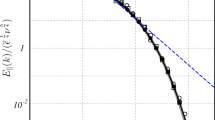Abstract
In this study, we propose a new Low-Reynolds-Number (LRN)one-equation model, which is derived from an LRN two-equation(k-ε) model. The derivation of the transport equation, in principle, is based on the assumption that the turbulent structure parameter remains constant. However, the relation for the turbulent structure parameter a 1(=|−\(\bar u\bar v\)|/k) is modified to account for near-wall turbulence. As a result, the present one-equation model contains a term which takes the near-wall limiting behavior explicitly into account. Thus, the present model provides the correct wall-limiting behavior of turbulence in the vicinity of the wall and can be applied to the analysis of heat transfer. The validity of the present model is tested in channel flows, boundary layer flows with and without pressure gradient, plane wall jet, and flow with separation and reattachment. The calculated results showed good agreement with the direct numerical simulation (DNS) and experimental data.
Similar content being viewed by others
References
Rodi, W., Turbulence Models and Their Application in Hydraulics — A State of the Art Review, 2nd edn. International Association for Hydraulic Research-Publication, Delft (1984).
Jones, W.P. and Launder, B.E., The prediction of laminarization with a two-equation model of turbulence. Internat. J. Heat Mass Transfer 15 (1972) 301-314.
Jones, W.P. and Launder, B.E., The calculation of low-Reynolds number phenomena with a two-equation model of turbulence. Internat. J. Heat Mass Transfer 16 (1973) 1119-1130.
Nagano, Y. and Hishida, M., Improved form of the k-ε model for wall turbulence shear flows. Trans. ASME, J. Fluids Engrg. 109 (1987) 156-160.
Nagano Y. and Tagawa, M., An improved k-ε model for boundary layer flows. Trans. ASME, J. Fluids Engrg. 112 (1990) 33-39.
Abe, K., Kondoh, T. and Nagano, Y., A new turbulence model for predicting fluid flow and heat transfer in separating and reattaching flows — I. Flow field calculations. Internat. J. Heat Mass Transfer 37 (1994) 139-151.
Nagano, Y. and Shimada, M., Development of a two-equation heat transfer model based on direct simulations of turbulent flows with different Prandtl numbers. Phys. Fluids 8 (1996) 3379-3402.
Abe, K., Kondoh, T. and Nagano, Y., On Reynolds-stress expressions and near-wall scaling parameters for predicting wall and homogeneous turbulent shear flows. Internat. J. Heat Fluid Flow 18 (1997) 266-282.
Baldwin, B.S. and Barth, T.J., A one-equation turbulence model for high Reynolds number wall bounded flows. NASA Technical Memorandum 102847 (1990).
Spalart, P.R. and Allmaras, S.R., A one-equation turbulence model for aerodynamic flows. La Recherche Aerospatiale 1 (1994) 5-21.
Menter, F.R., Eddy viscosity transport equation and their relation to the k-ε model. Trans. ASME, J. Fluids Engrg. 119 (1997) 876-884.
Bradshaw, P., Ferriss, D.H., and Atwell, N.P., Calculation of boundary layer development using the turbulent energy equation. J. Fluid Mech. 23, (1967) 31-64.
Patankar, S.V., Numerical Heat Transfer and Fluid Flow. McGraw-Hill, New York (1980).
Hattori, H., Nagano, Y. and Tagawa, M., Analysis of turbulent heat transfer under various thermal conditions with two-equation models. In: Rodi, W. and Martelli, F. (eds), Engineering Turbulence Modelling and Experiments 2. Elsevier, Amsterdam (1993) pp. 43-52.
Hattori, H. and Nagano, Y., Two-layer turbulence model for heat transfer in wall turbulent shear flows. In: Proceedings 5th ASME/JSME Joint Thermal Engineering Conference. ASME, New York (1999) p. 227.
Kim, J., Moan, P. and Moser, R., Turbulent statistics in fully developed channel flow at low Reynolds number, J. Fluid Mech. 177 (1987) 133-166.
Kim, J., Collaborative testing of turbulence models. Data Disk No. 4 (1990).
Reynolds, A.J., Turbulent Flows in Engineering. John Wiley & Sons, New York (1974) p. 187.
Dean, R.B., Reynolds number dependence of skin friction and other bulk flow variables in two-dimensional rectangular duct flow. Trans. ASME, J. Fluids Engrg. 100 (1978) 215-223.
Zarbi, G. and Reynolds, A.J., Wall stress measurements in two-dimensional turbulent channel and boundary-layer flows, and the wall layer differences. Trans. JSME, Ser. B 58 (1992) 1378-1385 [in Japanese].
Nagano Y., Tagawa, M. and Tsuji, T., Effects of adverse pressure gradients on mean flows and turbulence statistics in a boundary layer. In: Durst, F., Friedrich, R., Launder, B.E., Schmidt, F.W., Schumann, U. and Whitelaw, J.H. (eds), Turbulent Shear Flows 8. Springer-Verlag, Berlin (1993) pp. 7-21.
Spalart, P. R., Direct simulation of a turbulent boundary layer up to Rθ = 1410. J. Fluid Mech. 187 (1988) 61-98.
6th ERCOFTAC/COST Workshop on Refined Flow Modelling. Organized by K. Hanjalić and S. Obi, Vol. 2 (1997).
Rajaratnam, N., Turbulent Jets. Developments in Water Science 5. Elsevier, Amsterdam (1976) p. 211.
Karlsson, R.I., Eriksson, J. and Persson, J., An experimental study of a two dimensional plane turbulent wall jet. Vattenfall Utveckling AB (1993).
Kasagi, N. and Matsunaga, A., Three-dimensional particle-tracking velocimetry measurement of turbulence statistics and energy budget in a backward-facing step flow. Internat. J. Heat Fluid Flow 16 (1995) 477-485.
Pei, C.Q., Hattori. H. and Nagano, Y., New low-Reynolds-number one-equation heat transfer model of turbulence. In: Nagano, Y., Hajalić, K. and Tsuji, T. (eds), Proceedings of 3rd International Symposium on Turbulence, Heat and Mass Transfer. Aichi Shuppan, Tokyo (2000) pp. 349-356.
Author information
Authors and Affiliations
Rights and permissions
About this article
Cite this article
Nagano, Y., Pei, C. & Hattori, H. A New Low-Reynolds-Number One-Equation Model of Turbulence. Flow, Turbulence and Combustion 63, 135–151 (2000). https://doi.org/10.1023/A:1009924002401
Issue Date:
DOI: https://doi.org/10.1023/A:1009924002401




